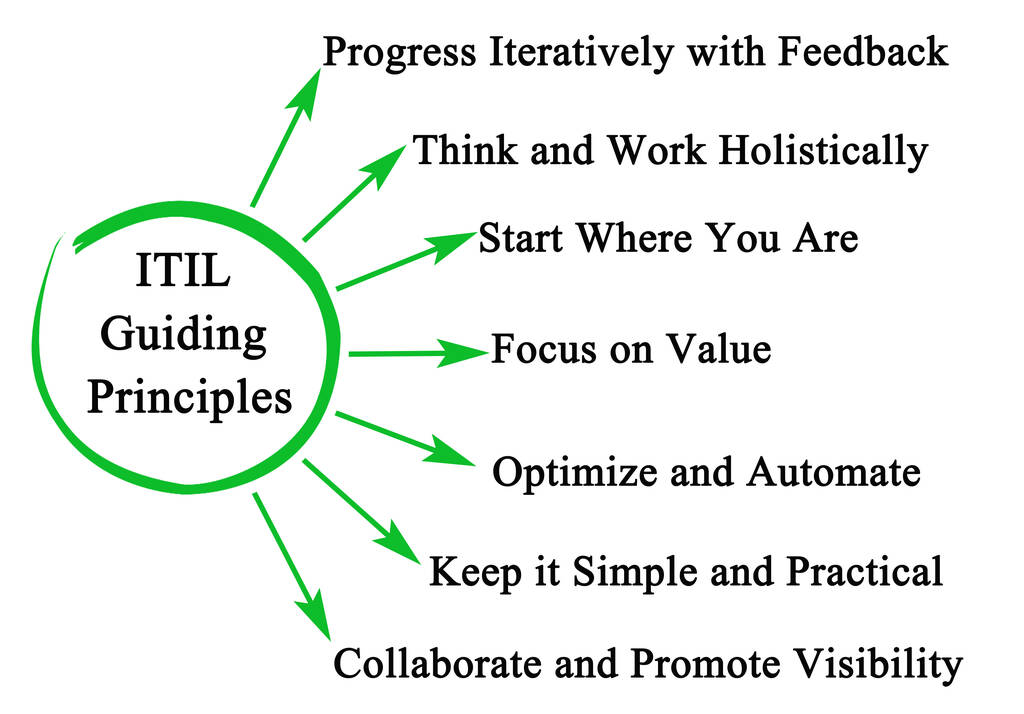In the ever-changing field of information technology service management (ITSM), success lies in embracing a set of guiding principles that direct organizations toward excellence rather than just putting procedures and practices in place. Let me introduce you to the ITIL Guiding Principles, a potent framework that acts as an ITSM professional’s compass, helping them to make wise decisions and promote continual progress. We reveal the importance and game-changing effect of the ITIL foundation certification and Guiding Principles in the field of IT service management in this in-depth investigation. The TOGAF certification enhances your IT service management journey if you are transitioning from ITIL. TOGAF goes into enterprise architecture, giving a complete framework for building, developing, and managing large systems. ITIL focuses on service lifecycles. They enable experts to traverse both the service management and architectural environments, supporting overall IT excellence.
Comprehending the Fundamentals of ITIL Guiding Principles:
The cornerstone of the ITIL framework, the ITIL Guiding Principles, is a collection of generally applicable standards that guide decisions and actions inside an organization. These guiding principles are not strict guidelines but rather adaptive and flexible axioms intended to support ITSM practitioners in any situation. Gaining an understanding of the fundamentals of each principle is essential to maximizing their ability to guide businesses toward success.
Emphasis on Value: This is the central tenet of ITIL’s Guiding Principles. This principle highlights how crucial it is to make sure that every action and endeavor helps to create and deliver value for stakeholders and customers, whether directly or indirectly. The Focus on Value concept makes sure that every action is in line with the main objective of generating quantifiable and visible value in a quickly evolving IT environment where the emphasis is on creating solutions that match business demands.
Begin at your current location:
This idea recognizes how things are in an organization right now. It encourages professionals to begin the journey of change from their current position rather than calling for a total overhaul. Starting where you are enables an approach to continuous improvement that is both realistic and practicable, regardless of the stage of the ITSM transformation an organization is at.
Iteratively Move Forward with Feedback: The ITIL framework acknowledges the dynamic character of ITSM. Progress Iteratively with Feedback emphasizes how crucial it is to make little adjustments in response to evaluation and feedback. Organizations can learn from past experiences, adjust to changing conditions, and constantly improve their processes to suit changing business requirements by using this iterative strategy.
Work Together and Increase Visibility: In ITSM, cooperation is a critical factor in success. The necessity of collaborating across teams, departments, and organizational levels is emphasized by this notion. Organizations may break down silos, share knowledge, and establish a transparent culture that improves overall effectiveness and efficiency by encouraging open communication and visibility.
Think and Act Holistically: An integrated perspective is crucial in the networked world of IT services. Thinking and operating holistically entails taking into account the organization as a whole and acknowledging the interdependence of its various parts. This concept aims to ensure that decisions and actions are in line with the larger corporate environment by encouraging professionals to comprehend the interactions and impacts between various parts of ITSM.
Remain Practical and Simple: Intricacy can impede effectiveness. Avoiding needless complication in procedures and practices is advocated by the “keeping it simple and practical” philosophy. Organizations may improve user experience, cut down on error risk, and streamline procedures by emphasizing pragmatism and simplicity.
Optimize and Automate: This strategy pushes companies to always look for ways to become more efficient while also encouraging them to do so. Automation is the use of technology to minimize physical labor, whereas optimization is streamlining procedures to maximize efficiency. When taken as a whole, these components guarantee that businesses are not only effective but also well-prepared to meet the needs of a constantly changing IT environment.
The ITIL Guiding Principles’ Transformative Power:
It is one thing to understand the ITIL Guiding Principles; it is quite another to realize their transformative potential, which is what causes organizations to undergo a true paradigm shift in ITSM. Now, let’s explore the particular domains in which these principles lead to significant transformation and promote excellence.
Making strategic decisions is essential for success in the always-changing field of ITSM. The ITIL Guiding Principles serve as a framework for professionals to make decisions that maximize value and are in line with organizational objectives. The principles function as a strategic compass, guaranteeing that every choice made affects the organization’s overall success, whether it be in the assessment of new technology, the streamlining of current procedures, or the creation of new services.
Cultural Transformation: The ITIL Guiding Principles’ ability to promote an organizational culture shift is one of their most important effects. Organizations can foster a collaborative, customer-centric, and continuous improvement culture by incorporating these ideas into their everyday operations. This change in culture not only improves worker engagement but also puts the company in a stronger position to handle the challenges of the digital age with adaptability and resilience.
Enhanced Service Delivery: The design, delivery, and optimization of services are all directly impacted by the ITIL Guiding Principles. Value-based thinking makes ensuring that services meet customers’ requirements and expectations. Continuous improvement of services based on real-world experiences is possible by starting where you are and moving forward iteratively with feedback. By fostering a cohesive approach, collaboration, and holistic thinking guarantee that services are provided throughout the company with ease. Organizations ensure efficiency and adaptability in service delivery by keeping things straightforward and practical and by streamlining and automating processes.
Enhanced Customer Satisfaction: The foundation of a successful ITSM is improved customer satisfaction. The ITIL Guiding Principles immediately contribute to increased customer satisfaction because they place a strong emphasis on value and collaboration. Customers enjoy a greater quality of service when services are created and delivered with an emphasis on satisfying their needs, as well as when there is transparency and collaboration across teams. Customers are not only satisfied but also gain loyalty and trust as a result of this pleasant experience.
The dynamic nature of the IT landscape necessitates agility in the face of change. The ITIL Guiding Principles give companies the adaptability to effectively handle change, especially with regard to the emphasis on starting where you are and moving forward iteratively with feedback. Organizations can ensure a more coordinated response by anticipating the impact of changes across several areas through a holistic approach to thinking and operating. In a world where company needs and technology breakthroughs are always changing, this agility is priceless.
Using the ITIL Guiding Principles to Gain a Competitive Edge:
Utilizing the ITIL Guiding Principles gives firms a clear advantage in a highly competitive business climate. Here’s how businesses can use these ideas to their advantage to beat the competition:
- Adaptability and Creativity: The ITIL Guiding Principles are flexible standards that promote innovation rather than strict rules. Businesses that follow these guidelines provide a flexible and creative culture. By adopting a comprehensive perspective and fostering cross-functional cooperation, establishments can recognize prospects for novelty and promptly adjust to developing patterns. They are positioned as industry leaders thanks to their proactive approach, which enables them to foresee and satisfy their clients’ evolving needs.
- Efficiency and Cost Optimization: Three fundamental concepts that directly affect efficiency and cost optimization are keeping things straightforward and practical, optimizing, and automating operations. Operational costs are decreased by companies that automate processes, simplify workflows, and get rid of pointless complexity. In addition to increasing profitability, this efficiency enables businesses to deploy resources more wisely, spurring ongoing innovation and expansion.
- Improved Reputation and Trust: A positive reputation is directly related to customer satisfaction and trust. Businesses that give the ITIL Guiding Principles top priority in their service delivery gain a reputation for dependability, openness, and customer-centeredness. Consumers—internal or external—are more likely to trust businesses that promote efficiency, simplicity, and constant development while also delivering value. A good reputation in turn draws in top personnel and makes the company a partner of choice in the sector.
- Alignment with Regulatory Compliance: Adherence to compliance is mandatory in businesses with strict regulations. The ITIL Guiding Principles offer a methodical way to make sure that ITSM procedures follow legal requirements. Organizations can carefully execute changes and reduce the risk of noncompliance by starting where they are and working through feedback iteratively. This alignment shows a dedication to moral corporate conduct in addition to guaranteeing legal compliance.
- Empowered and Engaged Workforce: By granting employees more authority, the ITIL Guiding Principles support a positive workplace environment. Professionals feel more involved and a part of the organization’s mission when they are aware of the principles that direct their decisions and activities. Employees who work in a workplace that values collaboration, transparency, and a focus on value are more motivated and feel appreciated. Increased productivity and creativity are thus a result of an empowered and motivated workforce.
Accreditations and Instruction for Understanding ITIL Guiding Principles:
Gaining a thorough grasp of how the ITIL Guiding Principles are applied in practical situations is essential for mastering them. Professionals who complete formal training programs and certificates are equipped with the information and abilities necessary to successfully apply these concepts. The following credentials and training programs can help ITSM practitioners become adept at applying the ITIL Guiding Principles:
- ITIL Foundation Certification: The entry-level credential that offers a basic comprehension of the ITIL framework, including the Guiding Principles, is the ITIL Foundation certification. Professionals who obtain this certification will be well-equipped to implement the principles in their professions and make valuable contributions to ITSM projects.
- ITIL Practitioner Certification: The Guiding Principles and other ITIL ideas are used practically in the context of the ITIL Practitioner certification. It gives professionals the know-how to apply and modify ITIL concepts in various organizational settings, promoting ongoing development.
- ITIL 4 Managing Professional Certification: The ITIL 4 Managing Professional certification is a thorough qualification for individuals hoping to lead ITSM efforts. It gives professionals the knowledge and abilities to oversee the whole ITIL service value chain and covers a variety of ITIL practices, such as the Guiding Principles.
- ITIL Master Certification: According to the ITIL framework, the ITIL Master certification is the highest level of accreditation. Candidates must be able to show that they have a thorough understanding of ITIL principles, especially the Guiding Principles and that they can apply them in challenging, practical situations. Mastery of the ITIL framework is demonstrated by obtaining the ITIL Master certification.
Accredited training programs in ITIL give professionals a thorough understanding of the framework, which includes the Guiding Principles. These courses, which are taught by knowledgeable professors, feature case studies, real-world applications, and interactive learning activities that improve comprehension and skill development.
Gazing Forward: Utilizing ITIL Guiding Principles to Future-Proof ITSM:
As companies persist in managing the intricacies of the digital age, the ITIL Guiding Principles prove to be an indispensable resource for safeguarding ITSM procedures in the future. Organizations can position themselves for long-term success by adopting a culture based on these values in the following ways:
Keeping Up with Technological Developments: New technologies like blockchain, AI, and machine learning are changing the way IT services are provided, and the IT industry is changing at a rate never seen before. Organizations may easily incorporate these technologies into their ITSM procedures thanks to the framework provided by the ITIL Guiding Principles, which guarantees that they will always be at the forefront of innovation.


